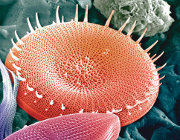Home :: List of Publicly Available Datasets :: Undescribed Undescribed D1
Undescribed Undescribed D1
Downloads:
| Principle Investigator(s) | Brian Palenik |
|---|---|
| External sample ID | CercozoanNOSYN |
| NCGR Sample ID | MMETSP0086_2 |
| Sample accession number | CAM_SMPL_002368 |
| Assembly accession number | CAM_ASM_000186 |
| Combined Assembly Name | Undescribed-sp-D1 |
| Genus | Undescribed |
| Species | Undescribed |
| Strain | D1 |
| Clonal | Yes |
| Axenic | No |
| Prelim. NCBI Taxon ID | 136419 |
| 18S rRNA | |
| Importance of organism and transcriptomes | Cercozoans are frequently found in 18S rRNA clone library surveys of marine environments and are thus considered ubiquitous in marine environments. They likely consume bacteria including cyanobacteria as prey, and thus are involved in recycling of nutrients through the microbial loop. Their biology is not well studied and we could not find a genome project for this group. This isolate was obtained from the SIO pier (UCSD, La Jolla, CA), has been in culture for more than a year and grows on a single Synechococcus strain and contaminating bacteria as food. This group would be important for phylogenetic reasons as part of a poorly sampled superfamily and for ecological reasons. We would hope to compare its transcriptome during growth with and without Synechococcus and to other nanoflagellates growing with and without Synechococcus. |
| Additional citations and references | |
| Environmental Data | |
| Primary citation for organism's characterization, if available | Bass, D; Howe, AT; Mylnikov, AP et al. (2009) Phylogeny and Classification of Cercomonadida (Protozoa, Cercozoa): Cercomonas, Eocercomonas, Paracercomonas, and Cavernomonas gen. Nov. PROTIST Volume: 160 Issue:4 Pages:483-521 |
| Experimental Data | |
| Date of experiment | 15-MAR-11 |
| Growth medium | f/4 amended seawater |
| Temperature (ºC) | 20 |
| Salinty (psu) | 34 |
| pH | 8 |
| Light (µmol photons / m2 / sec) | 20 |
| Day portion of day:night cycle in hours | 24 |
| Nitrate (μmol/L) | 441 |
| Phosphate (μmol/L) | 18 |
| Trace elements (total) (nmol/L) | 12.25 |
| Prey organism, if applicable (genus and species) | Unknown bacteria |








